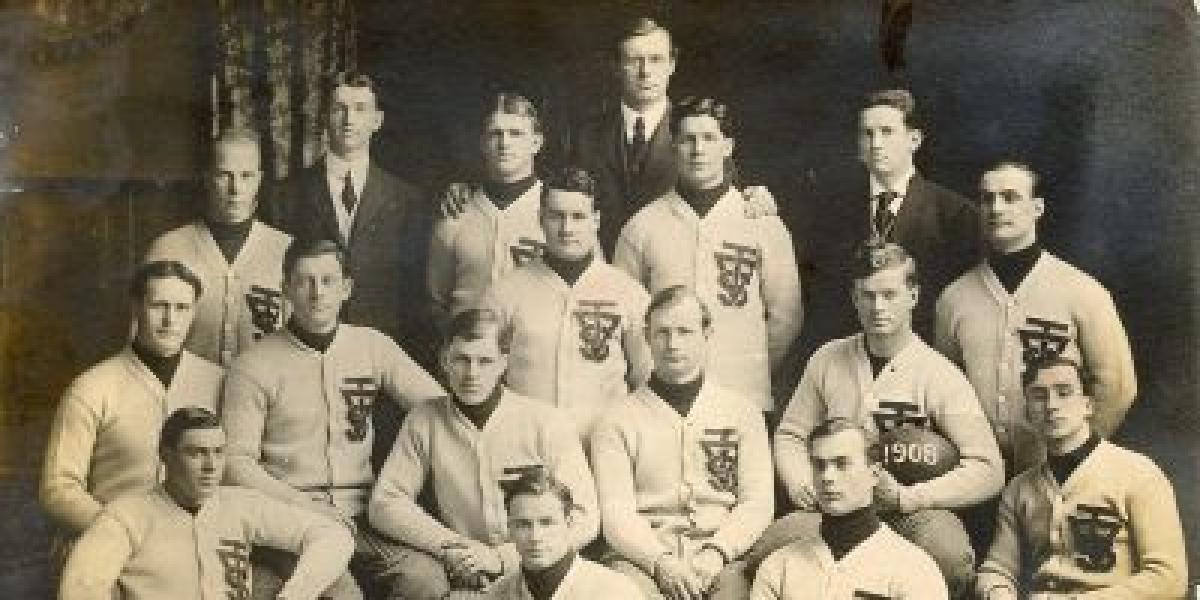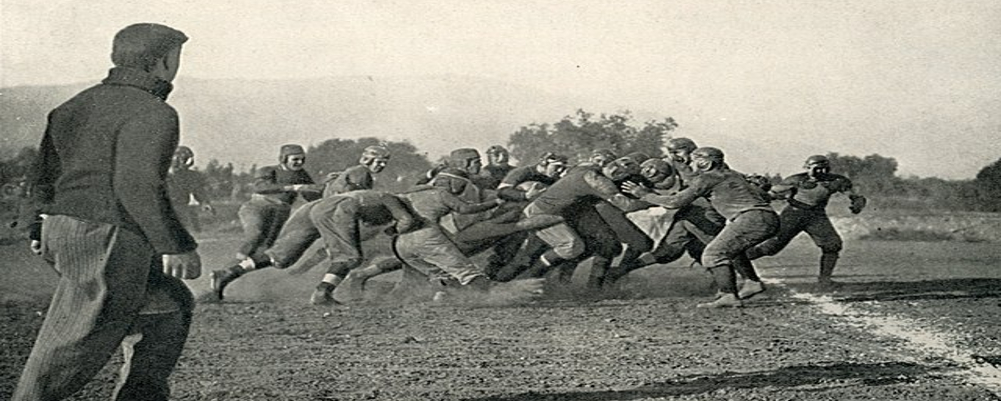Today, we're thrilled to welcome Timothy P. Brown, the mastermind behind the fascinating website footballarchaeology.com. Mr. Brown has dedicated his research to uncovering the forgotten stories and hidden origins of the game we love.
In this special post, we'll delve into the often-overlooked role the YMCA played in shaping American football. Through a conversation with Mr. Brown, we'll explore how this organization fostered the development of the sport, nurtured its early pioneers, and ultimately helped lay the groundwork for the gridiron giants we witness today.
So, buckle up and get ready to embark on a journey through the fascinating history of American football, where we'll unearth the surprising influence of the YMCA!
Here is the full transcript of the conversation with Timothy Brown on the YMCA's influence on football
Darin Hayes
Welcome again to the pig pen, your portal to positive football history. And welcome to Tuesday football, archeology .com day. Timothy P. Brown, the host of that website, is here to visit again, as he does every Tuesday. Tim, welcome back to the pig pen.
Timothy Brown
Hey, thank you, Darin. I'm looking forward to talking about a song. Well, it's not; it's about a subject related to a song that we can't talk about and that we can't sing or play because of copyright restrictions.
Darin Hayes
But, audience, we can share with you that Tim is dressed like an Indian chief, and I am dressed like a construction worker as we are talking about the subject, but we're just kidding. But of course, we are talking about the great organization of the YMCA. We have probably heard of that before or attended or taken some swimming classes like I did; I have one not too far from me. And we have some great ties in football history with the YMCA history that Tim had in a recent tidbit. So Tim, why don't you take it away and share this great story with us?
Timothy Brown
Yeah, so, you know, this is one of these. One of the things that fascinates me about football is that it is a different type of organization that supported and helped football grow, especially in the early years. And so we tend to think of football as this thing that's run through schools, and then obviously, it became professionalized. And so the NFL and AFL and AFC and, you know, various semi-pro teams, whatever they're, you know, but there were, you know, back in the day, there were organizations like the American Legion after World War One, there were all kinds of industrial leagues, some of which are where the basis of the NFL, right. So, different kinds of organizations have influenced football's growth and one that is vastly underestimated, I think, by many is the YMCA. And so it came about in a couple of different ways. One is that, back in, you know, one of the arguments for playing football and justification for football was the Muscular Christianity Movement that came out of England. And so it's just kind of this, this belief in the mind and the body and the spirit and that, you know, football was a way to meld, you know, that all three of them came together in football and provided good training for young men who needed to be hardy, you know, da da da. And so, that philosophy matched very well with the YMCA, which also had, I believe, come out of England, but in any event, the YMCA had a school that is now Springfield College in Massachusetts, that was was a school to train people to go out into the world and be YMCA directors. So I mean, it was kind of like a seminary, or you can think about it however you want. But you know, this is when there weren't physical education majors anywhere, and if you wanted to become somebody who would go out and teach, you know, physical fitness. You know, you also bought into some of the, you know, the religious side of it, then the YMCA training school was the place to be. And so, you know, right after he graduated from, from Yale in 1890, Amos Alonzo Stagg shows up, but, you know, he becomes the football coach and, well, basketball wasn't invented yet, but he was a football coach and baseball coach at YMCA training school. Now, in those days, he also played for them. So he was, you know, a player-coach. And, you know, they played typically a bit of a, you know, and, you know, they kept playing, you know, for years, they're still playing today in Springfield, but, you know, they would like a lot of schools in the Northeast States to step up and play, you know, Harvard and Yale here and there. Most of them played, you know, a smaller college schedule, but they played; they were very competitive and had a lot of good players. And one of the guys on Stagg's teams, the two years that he coached there before he went to UChicago, one of the guys was John Naismith, who ended up inventing basketball while at Springfield. And another guy who's a little bit later was William Morgan, who invented volleyball. So, these schools were pretty influential and certainly created those two sports. And, and then, you know, playing football. And so, but, you know, their impact came from World War One. And the YMCA and its role is kind of underappreciated, you know, in training camp, any American training camp around the world, and then even those, like rest camps and stuff, you know, once and once they're in Belgium and France, and in England, had a YMCA hut. And so these were typically fairly simple structures. But, you know, they, they had stationery for the guys to write home, they had, you know, a library, just they taught classes, especially, you know, there was a lot of, you know, they weren't GIs yet, but they were, you know, the doughboys, a lot of them couldn't speak English, so they teach English classes. But another big emphasis was that they supplied, you know, what would be the equivalent now of $80 million worth of athletic equipment to soldiers. Now that was basketballs and tennis rackets, etc. But football was a big one. And so, if there were athletic events at a military camp in World War One, it was likely very much, you know, YMCA involvement in it. And so, you know, these are especially like the interregimental games rather than the all-star teams for a camp. So, you know, that was an opportunity, you know, this is a time when I think it was less than 5% of Americans went to college. And so they, you know, they might have played for some rinky-dink little high school team in the little farm town that they grew up in. This became an opportunity for them to experience, you know, well-coached, you know, and more sophisticated football. And so it was, you know, it really kind of democratized football, you know, the World War One camps. Because, I mean, the vast majority of guys of that age range, you know, served in some form or capacity or their brother did or, you know, so it, you know, really spurred interest in football. And, you know, there's many, you know, folks that had made the case that, you know, that military football in World War One was a key to spurring the development of the NFL, you know, because it just demonstrated that people would come and attend games played by these former collegians, these college all-stars that, you know, nobody had said that they would do that before, you know, the NFL before that, you know, the pro leagues before that were mostly like kind of steel town folks and guys who, yeah, some of them went to college, and some of them didn't. Still, it was, you know, more of a semi-pro field than what came in the 20s, you know, and then obviously really took off in the 50s and 60s. So anyways, it's just, you know, the YMCA is one of those organizations you don't think of as being influential in the development of football, but it was. And there was, you know, physical instruction for the Navy anyway. Was this guy named Walter Camp? So, I mean, they were connected, right?
Darin Hayes
Yeah, another interesting story comes out of that with Nay Smith and a connection to football innovation. And I wrote an article about three years ago about who was the first to wear a helmet was the question and nay, smith's name is thrown in there because he, he, I wouldn't say that he wore a helmet. He had a; it was described as his, uh, he was getting cauliflower ear from getting knocked around playing the line, you know, in 1891 game against Amherst is what I sort of narrowed down to going through some of the descriptions of it. I think that's a game on October 17th, 1891. His girlfriend at the time helped sew some flannel together and tie it around his ears so he wouldn't get boxed and be irritated with his ears. It was one of the first head coverings in football that was publicized. Uh, they were not like a rag tied around your head or something, you know, but something for protection on your head. So, it's just odd that, here, the inventor of basketball who gets credited, played at this small college and has had so many great sports sprout out of it and so many great sports stories that connect to football. I think that's just amazing. Yeah.
Timothy Brown
Yeah, he, well, he, I've used that image of Naismith with that headgear, I think, in one of my books, but you know, definitely in some of the writing. And I know I got that I got, you know, Naismith was Canadian. So I got that image from their equivalent of the National Archives; whatever, I can't think of the name right now. But yeah, it's a great image. He's playing center; he's snapping the ball with his hands. And, he's got that, the thing wrapped around his head. Yeah, I, you never know, you never know where stories will come from. And, and the, you know, what I enjoy is, you know, the links of one thing to another. Yeah, so that's fun.
Darin Hayes
And I think it's interesting, too, if you can; you made me think about it in this context. So here you have Amos Alonzo Stagg, who, I assume, graduated from Yale. I think he graduated from there. Yeah. So he graduates from Yale and gets his master's in a phys ed degree at YMCA school. Just today, we look at him like, Hey, what the hell was that? You know, you went to Yale, you know, and are going to get a phys ed degree, you know, but
Timothy Brown
Well, you know, he was. I think he was a divinity student at Yale, but I'm not positive.
Darin Hayes
Yeah, I think you're right.
Timothy Brown
But he was definitely, I mean, his whole upbringing, a very religious man. And, and so, yeah, it made sense. Right. And, and some of his, you know, the guy who became president at U Chicago, knew him at Yale because he'd been, you know, faculty there. And just, you know, so he knew the character of Stagg. And, you know, he's an excellent athlete, one of the best baseball pitchers of his time. And so, that's part of why he said, hey, I want you to come out here.
Darin Hayes
I'm just putting in today's context. If my kid graduates from Ivy League after paying that and says, hey, I'm going to go to community college to get a phys ed degree too, because that's what I want to do. You're like, what do you mean you'll do that? You know, let me choke you first. But yeah, great stuff. That is a very interesting story. And it has so many webs and tentacles coming off, and it's just awesome. And I'm sure, you know, that connects to a bunch of your other tidbits. And you have these tidbits to come out every day, about 7 pm. They're very enjoyable. And, you know, talk about some great parts of football history that aren't mainstream but are very interesting. Indeed, maybe if you could share how folks could get their hands on those every day, too, that would be some enjoyment for them.
Timothy Brown
Yeah, so, you know, my site is footballarchaeology.com. You just go out there and subscribe, and once you're subscribed, you'll get an email with that day's story every day. And then, you know, kind of read them at your leisure. Alternatively, I'm under the same name, Football Archaeology; I'm on Twitter threads and on the sub-stack application. So, however, it works for you, if you want to read it, that's how you get to me.
Darin Hayes
Well, that's very good, Tim. We appreciate you preserving that football history each and every day, coming on each week, and sharing with us. And, uh, we want to talk to you again next week, and we appreciate you.
Timothy Brown
Thank you. That's very good. I look forward to it.



